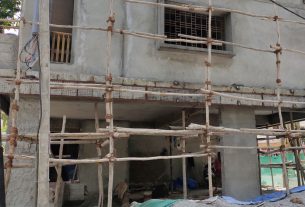High rates in India’s caesarean section (C-sections) births have led midwives to point out the gaps in conventional Indian healthcare and how they struggle to fit into the medical picture.
Indian midwives say the Indian health system has no place for their natural birthing profession. Birthing practices that harm mothers and children are popular despite the government stating that midwifery can reduce the number of caesarean sections.
“Even though the government started initiatives in 2018, there has been no steady implementation. The curriculum is poor because midwifery is still not regarded as a separate profession in India—a nurse can end up becoming a midwife with hardly a few months of training. Is this really enough?” said Indie Kaur, a UK-based midwife.
According to the National Health Family Services (NFHS)5, 47.7 percent births in private health facilities are C-section births. In 2018, the Indian government launched the Midwifery Services Initiative under the National Health Mission (NHM). The initiative aimed to promote midwifery to enable natural birthing and reduce C-Sections. It states that a midwife needs to have 18 months of training.
Julie Ryan Gerland, the co-founder and Chief Executive Officer (CEO) of Birthing the New Humanity, an initiative to raise awareness about conception, childbirth, and overall human development has actively pushed for the natural birth process for 40 years.
“We lobbied at the United Nations (UN) to get midwives recognized. The issue with the conventional medical system is that there is an overmedicalization and that everything is about money—doctors are taught to expect things to go wrong,” she said.
Sister Sicily Chittilappilly, former administrator, St. Philomena’s Hospital, Bangalore, said that there is less transparency in the medical system. “Ideally, in order to have a natural birth, a woman needs to have strong contractions. When this does not happen, doctors are supposed to give a combination of oxytocin and glucose—oxytocin is a hormone that induces these contractions.”
She added that if a woman has strong contractions, she does not need oxytocin and glucose and can give birth naturally. “But Caesarean births mean more money for the hospital. So even if glucose is not required, doctors give the woman glucose just to increase her fears of the birth being abnormal. And when that fear increases, it is a caesarean—the cycle just continues.”
Asha Kilaru,co-founder of the Bangalore Birth Network, thataims to give mothers a safe and supportive environment,said that a part of the third Sustainable Development Goal (SDG) ‘Ensure healthy lives and promote well-being for all, at all ages’ aims to reduce the Maternal Mortality Rate (MMR). According to the United Nations Children’s Fund (UNICEF), maternal mortality deaths are caused due to complications from childbirth.
Asha said, “The Indian health system wanted to reduce the number of deaths so they did C-sections, but what they do not realise is that unnecessary C-Sections will only do harm to the woman.” She added that natural births are the healthiest type of birth for women. “That is where midwives become important. It is good that the government has started initiatives, but I think they should have included traditional midwives into the health system right from the start.”
Julie also said there are psychological effects on the woman during the pregnancy. “When you put fear into a woman’s mind, her body cannot function properly. How can she have a natural birth then? The medical system eventually takes over and performs a C-section,” she said.
However, some women prefer to deliver at hospitals. “I am due in January and to be honest, I feel more confident and comfortable in a hospital. What if there is a complication at the last moment?” said Vaishnavi.
Dr. Evita , chairperson of the Fernandez hospital , Telangana , has been an obstetrician for 36 years. In 2011, she set up an in-house midwifery programme in Fernandez hospital and has been working closely with the Telangana government under NHM to help rural women give birth with the help of midwives.
She said, “Like many medical students decades ago and today, I was taught that birth was a catastrophe; we were taught to find everything that was wrong in the birthing process.”
She added, “I started to question things. Was traditional obstetrics really doing more harm to woman than help? And once I realized the answer was harm, I have never looked back. And I do wish the textbooks see it this way too. Rewrite those textbooks please.”
Although the Midwifery Services Initiative states that the medical curriculum lacks information about midwives, there has been no update in the curriculum. MBBS student Anagha said, she does not know about midwives. “My syllabus has never taught me who a midwife is and what he or she does. I would love to learn though.”
Dr. Evita said, “I am sure that if medical students actually watch a natural birth done by a midwife, they will be utterly mesmerized at the beauty of nature.”
She also added that there is a problem in the midwife qualification process. She said that the profession of a midwife should be treated as an individual profession where there must be individual qualifications. “For instance, an auxiliary nurse midwife gets 18 months of training. She barely gets any experience in delivering children and is suddenly expected to be an expert. How does that work? Shouldn’t she be trained just as well as other medical professionals?”
Qualified midwives feel that midwifery should be a separate curriculum like in other countries. Midwife Indie Kaur said, “Sometimes, they get trained for three to six months and that isn’t enough. 18 months is ideally recommended. I feel there needs to be honesty in the health system.”
Dr. Evita added that although policies are good, they need to be implemented at the grassroot level across urban and rural areas.
Asha Kilaru also said that there is huge disparity in access to midwives. “The urban, English-speaking upper middle class is aware of midwives. And they can access them too. Private midwifery costs a lot and this literally denies a whole section of society the birthing care that they deserve.”
No place for Doulas
While midwives aid in the actual birthing process, doulas are professionally trained companions that provide emotional support to the mother before, during and after the birth. But the Midwifery Services Initiative does not state any information about a doula.
“Nobody values emotional care anymore—it is almost like the woman is a machine to birth baby after baby. People fail to realize that a huge part of birth is about kindness. A doula is like a friend who provides that warmth and support,” said Julie.
Julie said that people should be educated about midwives and doulas. “Awareness is so important in this era where we seem to place all our hopes on one doctor. We need to put it all out there; it could be advertisements, shows or anything that just tells women what this is all about and how they can take charge of their birthing process.”
Neha, a Bangalore-based Doula, said, “We have nurses and doctors, but no one bothers about midwives and doulas. In our race to birth, we forget about life itself.”




